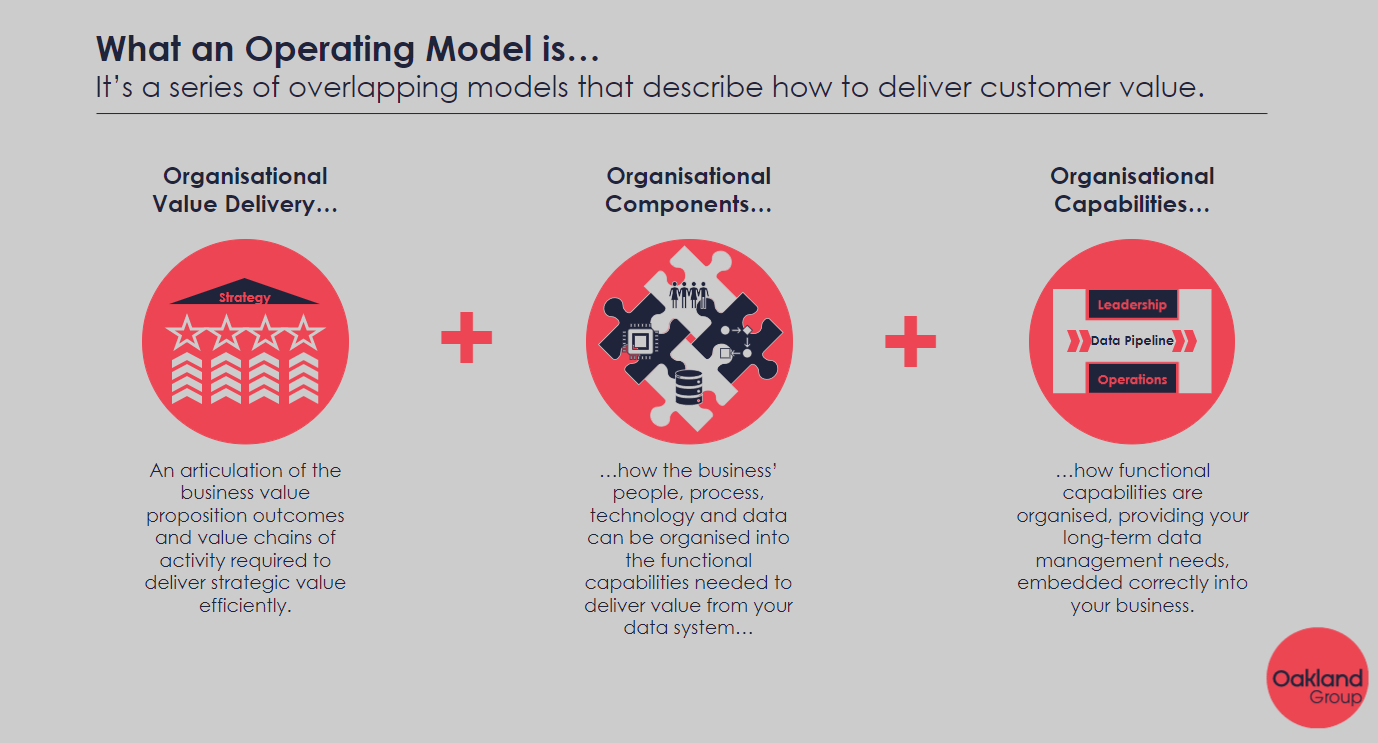We don’t have a particular affinity with 00’s hip-hop. But we tend to hear something like this when data projects admit they are in difficulty or aren’t getting traction. It’s generally the data strategy that’s to blame, right?
Not in our experience.
Don’t get me wrong, the data strategy could just be ‘wrong’ but it’s a rare thing. We discussed strategy in an earlier blog here – https://www.theoaklandgroup.co.uk/a-data-strategy-is-not-a-strategy-for-data/
Even the best data strategies will struggle if expectations are unrealistic, or a strategy is taken as a ‘final answer’. In this scenario, strategy is seen as being something it isn’t – a magical document that will materialise into physical capabilities working collaboratively to achieve strategic objectives. It won’t and it never will. It’s the Target Operating Model that needs to stand up!
Firstly, strategy fails because there isn’t enough traction with the group of stakeholders required to make it succeed. And generally, that’s because the change isn’t mapped out as an understandable roadmap of changes. Getting this sort of view is where the rubber starts to hit the road.
Remember, data provides services to a customer and uses a service input from other areas. As fabulous as they are, Data Organisations are not self-contained, and they are not self-sufficient. Unless both customer and service provider understand the strategy and practical change and implications, how can they get on board with what you intend? This failure of communication and understanding is key. Customers always want better service but not if they lose what they have. Service providers would prefer to do less at lower cost and not more at the same cost.
Understanding implication and value are essential ingredients to getting key stakeholders aligned.
The second issue relates to “strategy for data or data for strategy”. The business’ strategy tends to cascade and generate a whole myriad of strategies. Finance, Risk, Marketing, Customer, Product, Asset, the list goes on. And each of those strategies in turn may resolve into more strategies. Leaders tend to circle around their own strategy and fend off threats to it. Data Strategy is no different and neither are its behaviours.
It’s every person for themselves – but don’t panic it’s all going to land right and deliver. Alrighty then…
We have a problem here!
This is where the Target Operating Model becomes the real “north star” that’s needed by the business. Strategy is great, but winning any race is about the preparation before the race itself. This means describing the value chain of activities that deliver outcomes and the data capabilities that underpin those activities. Break your capabilities into tech, process, people skills, culture, and data features. This is where the Target Operating Model trumps the Strategy every time when it comes to executing change. Detail, specificity, prioritisation.

Target operating model design
The early stages are all about buy-in and convincing others that your plan is credible and achievable. That means demonstrating understanding of their issues with data and how your changes will resolve them. Being clear about specific, tangible capability change helps convince stakeholders change is achievable. Being honest about the scale of change, support requirements and risk enhances your credibility.
Laying out the principal value chains of data activity is imperative. It’s the first layer of detail connecting strategic outcomes to their physical delivery. The ‘what’. Importantly for your stakeholders, you understand what the business is attempting to achieve and have methods that align. You also have a view on the pain they experience using ‘today’s’ methods.
Those activities break into key organisational components: people, process, tech, and data. The ‘how’, and ‘who’ or ‘what’. For your stakeholders, you have a handle on the more granular process details and capability maturity. Importantly, you can talk to them in terms of physical building blocks that relate to them and their issues as a customer or service provider. Remember, you have a spread of stakeholders, and they all probably have different problems to solve.

You can provide a view on how your capability designs are arranged within the business and how that arrangement will fulfil the longer-term strategic needs of the business. The ‘when’ and ‘where’. Linkages between different areas of capability specialism can be demonstrated. The overall impact and effect of your approach can be effectively communicated.
And finally, you can provide a much clearer evidence-based view of the order of priority – the roadmap of change. Let’s face it, most people don’t set out on a 1000-mile road trip without some idea of the route.
The Target Operating Model provides layered detail for discussion, challenge, and modification. Who doesn’t like a bit of shrewd discussion and bargaining? And the bargaining is worth it when it comes to “data” – good data is usually in short supply.
Showing your method and being inclusive with key stakeholders helps solve the second issue of gaining alignment. Having a Business Strategy for data helps to make “data” an organisational effort. Everyone is involved, everyone is impacted.
This doesn’t mean there won’t still be a series of strategies in delivery across the business, but at least the data strategy is shared. By being aligned with the areas that most influence and support it because they rely on it. Sharing is a wonderful thing, especially when everyone wins.
Alex Guy is a design and architecture specialist at Oakland


